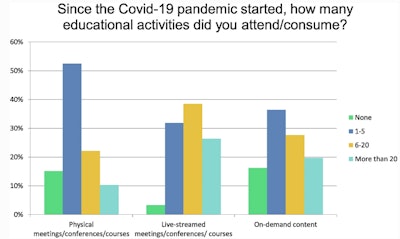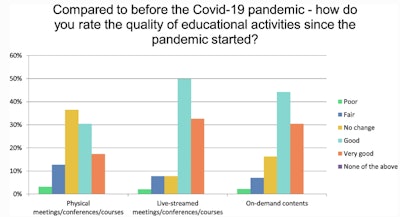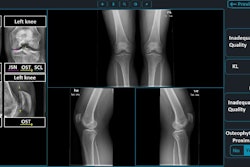A large survey of European Society of Radiology (ESR) members has highlighted that live educational events remain as popular as ever, but e-learning is poised for continued growth, particularly among the younger generation.
The shift toward a unified continuing medical education/continuous professional development (CME/CPD) system in Europe is also favored by most respondents, first author Dr. Miraude Adriaensen, PhD, from the Department of Medical Imaging, Zuyderland Medical Center, Heerlen, The Netherlands, and colleagues noted in an article posted on 1 August by Insights into Imaging.
The authors' aim was to assess the evolution of onsite, live educational events versus remote (e-learning) participation and the impact of the COVID-19 pandemic.
On 4 March 2023, the Accreditation Council of Imaging (ACI) sent out a survey about online education trends to all 80,623 ESR's full and corresponding members, and the survey remained open for two weeks. The ACI, which was formed in 2015 by the ESR/European Board of Radiology and the European Union of Medical Specialists (UEMS), had previously conducted several surveys between 2017 and 2020 to gauge the training needs of participants and to improve CME for the future.
A total of 543 answers were received, making a response rate of 0.67%. Pre-pandemic, 90% of European radiologists supported mandatory CME and unified CME/CPD-system. A trend among younger radiologists towards e-learning was observed. Only 20% of employers fully endorsed CME/CPD. In 2020, attendance at live educational events dropped significantly (95.5%-33%), with a simultaneous surge (33%-58%) in time spent on e-learning.
 Types and quantity of different educational activities of participants since the start of COVID-19 pandemic. All figures courtesy of Dr. Miraude Adriaensen et al and Insights into Imaging).
Types and quantity of different educational activities of participants since the start of COVID-19 pandemic. All figures courtesy of Dr. Miraude Adriaensen et al and Insights into Imaging).
Postpandemic, around 52% of live educational events attendees participated in one to five events, and 22% attended six to 20 meetings. For live-streamed events, 38% participated in six to 20 meetings, followed by 32%, who attended one to five meetings, and 26% attended more than 20 events.
Content remains a priority of respondents in all formats: 79% for online, 75% for onsite, and 74% for on-demand. Speakers were considered essential or highest priority when choosing onsite events (61%), online events (59%), and on-demand content (55%).
The schedule was a common priority for live-streamed events (58%), and onsite events (53%). It was, however, less important for on-demand content (41%). CME credits were less of a priority when choosing either onsite events (39%), online events (42%), or on-demand content (34%).
Respondents assessed the quality of live educational events since the beginning of the pandemic compared with the quality of live educational events before the pandemic, with 36% indicating no change and 48% describing it as good/very good. In contrast, 83% of respondents described the quality of live-streamed events as good/very good compared to the quality before the pandemic. Similarly, 75% rated the quality of on-demand events as good/very good compared with the quality before the pandemic, indicating an increase in the quality of e-learning content since the beginning of the pandemic.
 The quality of various educational activities since the pandemic started.
The quality of various educational activities since the pandemic started.
For on-demand topics, 36% of respondents downloaded one to five e-learning materials and 28% downloaded six to 20 e-learning materials. About 60% of respondents consumed live-streamed events outside working hours, while an even greater percentage (75%) did the same for on-demand events.
The interactivity between attendee and speaker/moderator during live-streamed events was rated positively by 59% of respondents, with responses indicating good, very good, or excellent experiences. Many of them liked audience participation during live-streamed events, particularly opportunities for anonymous questions via Q&A or chats.
Most participants rated the benefits and quality of live-streamed (84%), as well as on-demand events (83%) as good, very good, or excellent, compared with onsite events.
People's preferences
Several comments highlighted the positive educational aspects of hybrid or online events. For instance: "In my opinion, all conferences should be hybrid and able to be watched on demand for several months after the event. Travel costs are getting more and more expensive. Live events are good for networking, etc. Improving knowledge and skills is best done in a quiet environment (i.e., not large noisy conference lecture rooms). And on demand is the best because then the lecture can even be stopped and repeated."
According to another respondent, "To study two ways has proved effective: 1. repetition and 2. reproduction. Both are often easier online (on-demand > live); for the theoretical knowledge, I often prefer online lessons, despite less interaction ... There is still a place for physical events."
This was the view of another participant: "The online discussions tend to be much more lively and fruitful than during the physical events because the attendees can type the questions instead of having to stand up and speak in front of an audience, hence the option to type questions (e.g., on smartphones) should be an option for physical events, too."
Overall, the majority of European radiologists support mandatory CME and a unified CME/CPD system, the authors noted. Despite the post-pandemic resurgence in live educational events, electronic learning materials and hybrid events are predicted to gain further prominence.
"The CME/CPD system dynamically adapts to evolving professional, technical, and environmental circumstances, with human interaction gaining heightened significance post-COVID-19," they pointed out.
The ACI provides a one-step service for CME accreditation, supporting the European Accreditation Council for Continuing Medical Education (EACCME).
You can read the full Insights into Imaging article here. The co-authors were Prof. Paolo Ricci, from Sapienza University of Rome, Dr. Helmut Prosch, from Medical University of Vienna, and Dr. Mitja Rupreht, from UMC Maribor, Maribor, Slovenia.



















